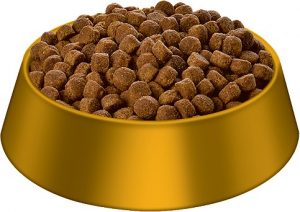
Note (8/3/18) Since we posted this blog, we came across an article by The Whole Dog Journal on grain-free kibble and thought our readers would appreciate it. Whole Dog Journal takes NO advertising and does a yearly analysis is different kinds and brands of dog food. They are very relaible. Here is their article: https://www.whole-dog-journal.com/blog/Please-Dont-Panic-About-the-Grain-Free-Thing-21893-1.html?ET=wholedogjournal:e309707:850190a:&st=email&s=p_Blog080218
As concerned pet parents, we’re always interested in providing the best nutritional requirements for our companion animals, realizing that there is a link between nutrition, health, and susceptibility to diseases, including skin issues and cancer, among others.
The latest study by the FDA warns that there may be a link between grain-free kibble and heart disease, especially in certain breeds.
This information has been circulating around the Internet for a few weeks now. What do you think? Is the Food and Drug Administration influenced by outside pressure from large dog food companies? What has been your experience with kibble food? Do you feed it as a staple? Do you add fresh foods to supplement your dog’s nutrition? What do you think of this recent study? Do you feed grain free kibble, and if so, what is your thinking, and what has been your experience? We’d like your feedback.
The FDA finds link between certain foods, breeds and canine heart disease
By Scott Johnson – Reporter
Source: News4Jax
JACKSONVILLE, Fla. – The U.S. Food and Drug Administration is warning pet owners about a potential link between certain types of dog food and canine heart disease.
Specifically, the advisory focuses on dog food that contains potatoes, peas, lentils and legumes, ingredients the agency warns can lead to dilated cardiomyopathy (DCM).
Dr. Craig Sandler, a veterinarian at Jacksonville’s Lakewood Animal Clinic, was among the animal experts News4Jax spoke with who weren’t familiar with the latest findings. “Grain-free, in general, appears to be an issue so I would tell people right now, until we have more information, don’t use a grain-free food,” said Dr. Sandler.
He said the ingredients themselves are not all bad. But, he noted, they shouldn’t be the primary ingredients listed on the label. “Because the label is by quantity of product in the food,” he said.
Added Sandler: “If the label says potato in the first few ingredient, you shouldn’t really be using that.”
Dan Maloney, the lead animal trainer at the Jacksonville Zoo and Gardens, was only learning of the study when contacted by News4Jax. He said dog foods are constantly evolving.
“I don’t think our dog food probably has any of that in there,” said Maloney. “… We’re trying to recreate a diet that has nothing to do with vegetables with the dogs, and I think that’s part of the challenge.”
The FDA study also found a lengthy list of dog breeds that are vulnerable to this issue, including Great Danes, Golden and Labrador retrievers, Whippets, Shih Tzu, bull dogs and miniature schnauzers.
Dog owners who spoke with News4Jax ranged from those who were extremely concerned about the study’s findings to those who weren’t worried about it affecting their pets.
“I’ve heard that you don’t want potato as your second ingredient,” said Jill Renka, who noted she feeds her dog a blend that doesn’t contain any of the substitutes commonly found in grain-free dog food.
Katie Stuart said she doesn’t put too much stock in what food her dog eats. After all, she said, it’s not up to her.
“I just go with what he likes,” said Stuart. “I can’t control what he eats out here anyway.”
Pet owners who notice health problems in their dogs stemming from their diets are encouraged to notify the FDA. To report any issue you have, visit the website or call 1-888-INFO-FDA.
Check out this link for a helpful video.
Disclaimer
The Puppy Up Foundation does not endorse nor recommend any particular product, service, or treatment. We offer information strictly for educational and/or informational purposes. We believe it is the pet owner’s responsibility to do the research and draw his or her own conclusions.








